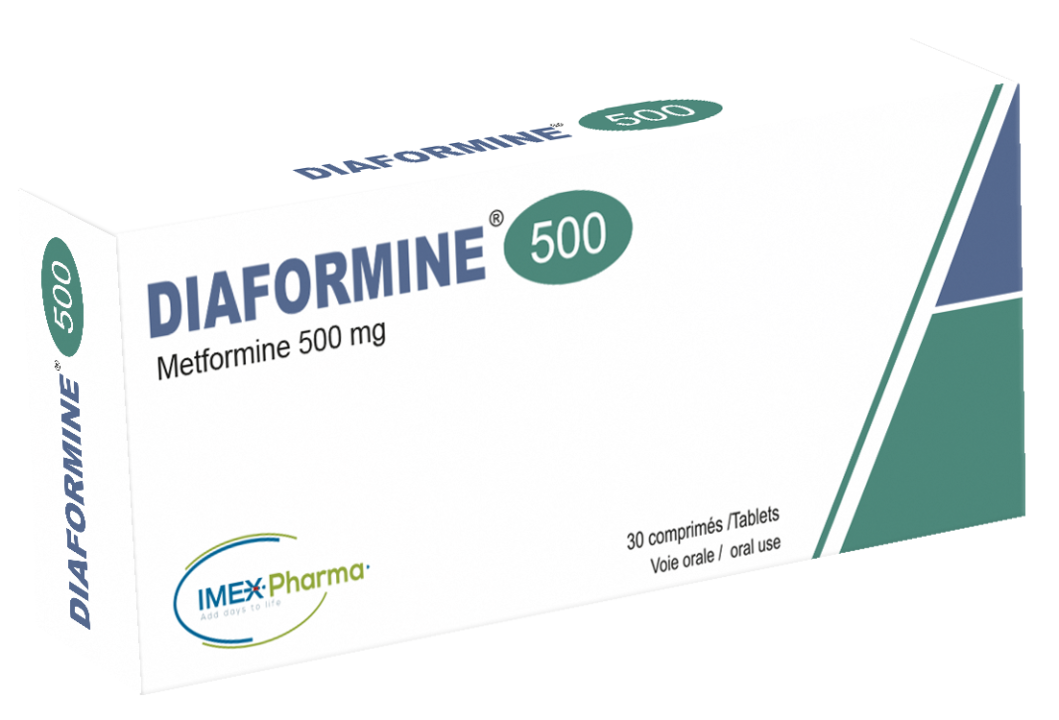500 mg/800 mg/1000 mg, film-coated tablet
> THERAPEUTIC INDICATION
DIAFORMINE contains metformin. It is a medicine used to treat diabetes. It belongs to a class of medicines called biguanides.
Insulin is a hormone produced by the pancreas that allows your body to take up glucose (sugar) from the blood. Your body uses the glucose to make energy or stores it for later use.
When you have diabetes, your pancreas does not produce enough insulin or your body is not able to properly use the insulin it produces. This results in high blood sugar levels in your blood. DIAFORMINE helps to lower your blood sugar to as normal a level as possible.
If you are an overweight adult, long-term use of DIAFORMINE can also help limit the risk of complications associated with diabetes. DIAFORMINE is associated with weight stability or modest weight loss.
DIAFORMINE is used to treat type 2 diabetes (also known as "non-insulin dependent diabetes") when diet and exercise alone have not been sufficient to control blood glucose levels. It is particularly used in overweight patients.
Adult patients may take DIAFORMINE alone or with other diabetes medications (oral medications or insulin).
Children aged 10 years and over and adolescents may take DIAFORMINE alone or with insulin.
> DOSAGE AND ADMINISTRATION
Always take this medicine exactly as prescribed by your doctor. Check with your doctor or pharmacist if you are unsure.
DIAFORMINE does not replace the benefits of a healthy lifestyle. Continue to follow your doctor's dietary advice and exercise regularly.
Recommended dose:
In children aged 10 years and over and adolescents, treatment is usually started with 500 mg or 850 mg of DIAFORMINE once daily. The maximum daily dose is 2000 mg in 2 or 3 separate doses. Treatment of children between 10 and 12 years of age is recommended only on the specific advice of your doctor, due to the limited experience in this age group.
In adults, treatment is usually started with 500 mg or 850 mg of DIAFORMINE two or three times daily. The maximum daily dose is 3000 mg in 3 separate doses.
If your kidney function is reduced, your doctor may prescribe a lower dose.
If you are also taking insulin, your doctor will tell you how much DIAFORMINE to take.
Monitoring
- Your doctor will check your blood sugar regularly and adjust the dose of DIAFORMINE you take according to your blood sugar level. Be sure to see your doctor regularly. This is particularly important for children and adolescents or if you are elderly.
- Your doctor will also check the condition of your kidneys at least once a year. More frequent checks may be necessary if you are elderly or if your kidneys are not functioning normally.
How to take DIAFORMINE, film-coated tablet
Take DIAFORMINE with or after a meal. This will help to avoid adverse effects on your digestion.
The tablets should not be crushed or chewed. Swallow each tablet with a glass of water.
- If you take one dose a day, take it in the morning (with breakfast).
- If you take two separate doses a day, take one in the morning (at breakfast) and one in the evening (at dinner).
- If you take three separate doses a day, take one in the morning (at breakfast), one at noon (at lunch) and one at night (at dinner).
If, after a while, you feel that the effects of DIAFORMINE are too strong or too weak, talk to your doctor or pharmacist.




